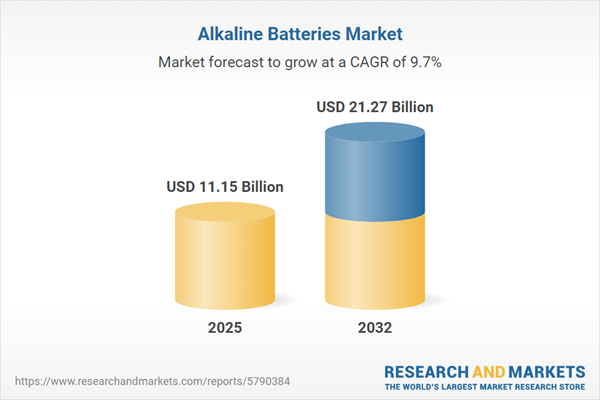Speak directly to the analyst to clarify any post sales queries you may have.
The alkaline batteries market is progressing rapidly as organizations embrace new procurement models, implement advanced technologies, and adopt responsible sourcing practices that support critical business functions and compliance. Senior decision-makers are increasingly focused on converting these emerging strategies into practical frameworks for ongoing operational reliability.
Market Snapshot: Alkaline Batteries Market Size and Growth
The global alkaline batteries market stands at USD 10.16 billion in 2024, with projections rising to USD 11.15 billion by 2025 and an anticipated Compound Annual Growth Rate (CAGR) of 9.66%. Looking ahead to 2032, the value trajectory is expected to reach USD 21.27 billion. Growth is supported by advancements in battery production and the rising demand across multiple settings, including residential, commercial, and industrial sectors. Organizations are overhauling procurement and supply systems to enhance product quality, build reliability into operations, and respond to rapid changes in device use worldwide.
Scope & Segmentation
- Battery Types: Sizes such as 9V, AA, AAA, C, and D drive compatibility across a spectrum of devices, spanning household electronics to B2B and industrial systems. This adaptability supports stable performance and minimizes downtime for mission-critical tools everywhere.
- Applications: Integral to products like clocks, toys, remote controls, appliances, and flashlights, alkaline batteries form the backbone of both high-use business equipment and essential consumer goods. Their reliability ensures devices deliver uninterrupted support in productivity-driven environments.
- Distribution Channels: Businesses access products through brand-owned e-commerce platforms, popular online marketplaces, electronics retailers, supermarkets, hypermarkets, convenience stores, and specialized B2B suppliers. This breadth of channels helps organizations select tailored sourcing strategies aligned with business priorities and regulatory requirements.
- End Users: The core market encompasses businesses, residential buyers, and industrial entities. Organizations pursue bulk procurement for uninterrupted supply in demanding applications, alongside flexible, just-in-time models to match evolving operational demands.
- Packaging Preferences: Choices span value packs, bulk quantities, and single units, with selection informed by inventory planning, predictability of consumption, and spend management targets for waste reduction.
- Geographical Coverage: The market encompasses the Americas, Europe, Middle East, Africa, and Asia-Pacific. Distinct regional conditions, from local regulations and technology infrastructure to logistics, influence sourcing, compliance actions, and adaptation strategies.
- Company Profiles: Leading companies—including Energizer Holdings, Duracell Inc., Panasonic Corporation, VARTA AG, GP Batteries International, Eastman Kodak Company, and Toshiba Corporation—establish global benchmarks for quality and innovation, shaping procurement trends and performance standards.
Key Takeaways for Senior Decision-Makers
- Sustainable sourcing continues to gain importance as companies prioritize transparent vendor practices and address shifting stakeholder requirements around ethical procurement.
- The latest battery innovations enable compatibility with legacy assets and cutting-edge systems, improving device uptime and delivering measurable support for mission-critical operations.
- Expanded use of recycled materials and the implementation of traceability across supply networks reinforce compliance initiatives and contribute to wider sustainability programs.
- Organizations blend longstanding distributor alliances with digital purchasing solutions to maintain flexible supply chains and ensure continuity in response to changing market demands.
- Procurement strategies now focus on aligning with regional priorities, with established markets prioritizing regulatory adherence and productivity improvements, while developing areas emphasize affordability and adaptive sourcing.
- Collaboration between manufacturers, suppliers, and downstream partners accelerates responses to regulatory updates and global supply chain shifts, supporting overall business continuity.
Tariff Impact on Alkaline Battery Supply Chains
Ongoing shifts in U.S. tariff policy prompt many organizations to realign sourcing strategies by diversifying their supplier base, boosting investment in domestic operations, and expanding activity in Southeast Asia. Streamlining distribution and implementing automation strengthens operational resilience and supports compliance in varied regulatory environments. These actions help limit the effects of price swings and supply uncertainties for both producers and end users operating globally.
Methodology & Data Sources
This analysis draws from executive-level interviews, focused industry surveys, and close review of regulatory and market documentation. Data verification is achieved through direct shipment records and expert validation, providing senior leaders with trusted input for procurement and operational strategy.
Why This Report Matters
- Gives executive teams actionable tools for building supply chain resilience and driving transformation in response to industry trends and compliance pressures.
- Enables buyers to optimize procurement processes and maintain agility across both well-established and emerging regional markets.
- Offers guidance to help organizations manage risk and develop enduring partnerships within the evolving alkaline batteries sector.
Conclusion
This report equips leadership with targeted insights to enhance procurement resilience and proactively address evolving supply chain challenges across the alkaline batteries market.
Additional Product Information:
- Purchase of this report includes 1 year online access with quarterly updates.
- This report can be updated on request. Please contact our Customer Experience team using the Ask a Question widget on our website.
Table of Contents
3. Executive Summary
4. Market Overview
7. Cumulative Impact of Artificial Intelligence 2025
Companies Mentioned
The companies profiled in this Alkaline Batteries market report include:- Energizer Holdings, Inc.
- Duracell Inc.
- Panasonic Corporation
- VARTA AG
- GP Batteries International Limited
- Eastman Kodak Company
- Toshiba Corporation
Table Information
| Report Attribute | Details |
|---|---|
| No. of Pages | 189 |
| Published | November 2025 |
| Forecast Period | 2025 - 2032 |
| Estimated Market Value ( USD | $ 11.15 Billion |
| Forecasted Market Value ( USD | $ 21.27 Billion |
| Compound Annual Growth Rate | 9.6% |
| Regions Covered | Global |
| No. of Companies Mentioned | 8 |









